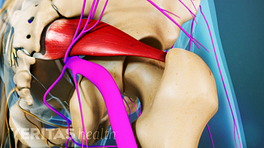Depending on the severity of the patient’s sciatica-type pain and other symptoms, a number of treatment options may be recommended by a health care professional.
A comprehensive approach to managing piriformis syndrome may include a combination of the following nonsurgical treatments:
Video: Piriformis Syndrome
Piriformis syndrome is an irritation of the sciatic nerve caused by the contraction of the piriformis muscle. Watch Now
Ice and Heat Therapy for Piriformis Syndrome
A simple way to help relieve discomfort at home is to apply a cold compress or heating pad to the skin over the painful area.
Ice Packs and Ice Massage
At the onset of pain, lie in a comfortable position on the stomach and place an ice pack on the painful area for approximately 20 minutes. Repeat as needed every 2 to 4 hours.
It may be more helpful to combine a gentle massage with the ice. Lie on the stomach and have someone gently massage the painful area with a large ice cube. If ice is applied directly to the skin (instead of a cold pack), limit it to 8 to 10 minutes to avoid an ice burn.
If specific activities are usually followed by increased pain, it may be a good idea to apply ice immediately following the activity.
Heat Therapy
Some people find it helpful to alternate cold with heat. If using a heating pad, lie on the stomach and place the heating pad on the painful area for up to 20 minutes. Be sure to avoid falling asleep on a heating pad, as this may lead to skin burns.
See Benefits of Heat Therapy for Lower Back Pain
Medications for Sciatica Pain
Since most episodes of pain include some type of inflammation, non-steroidal anti-inflammatory medications (NSAIDs), such as ibuprofen or naproxen, may help decrease inflammation in the affected area.
Piriformis Steroids
For severe sciatica pain from piriformis syndrome, an injection may be part of the treatment.
See Diagnosing the Cause of Sciatica
Piriformis injection
A local anesthetic and corticosteroid may be injected directly into the piriformis muscle to help decrease the spasm and pain. The purpose of an injection is usually to decrease acute pain to enable progress in physical therapy.
Botox injection
For persistent piriformis spasm that is resistant to treatment with anesthetic/corticosteroid injections, an injection of botulinum toxin (e.g. Botox®), a muscle weakening agent, may be useful. The goal of the injection is to help the muscle relax and help reduce pressure on the sciatic nerve.
The goal with both injections is to help the patient progress with stretching and physical therapy, so that when the effect of the injection is over the muscle will be remain stretched and relaxed.
Electrotherapy for Piriformis Syndrome
The application of electrical stimulation to the buttock with a transcutaneous electrical nerve stimulation (TENS) unit or interferential current stimulator (IFC) can help to block pain and reduce muscle spasm related to piriformis syndrome.
In persistent cases, the piriformis muscle can be cut to relieve symptoms, but this is rarely performed.







